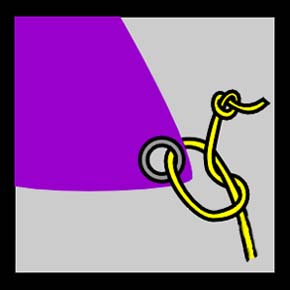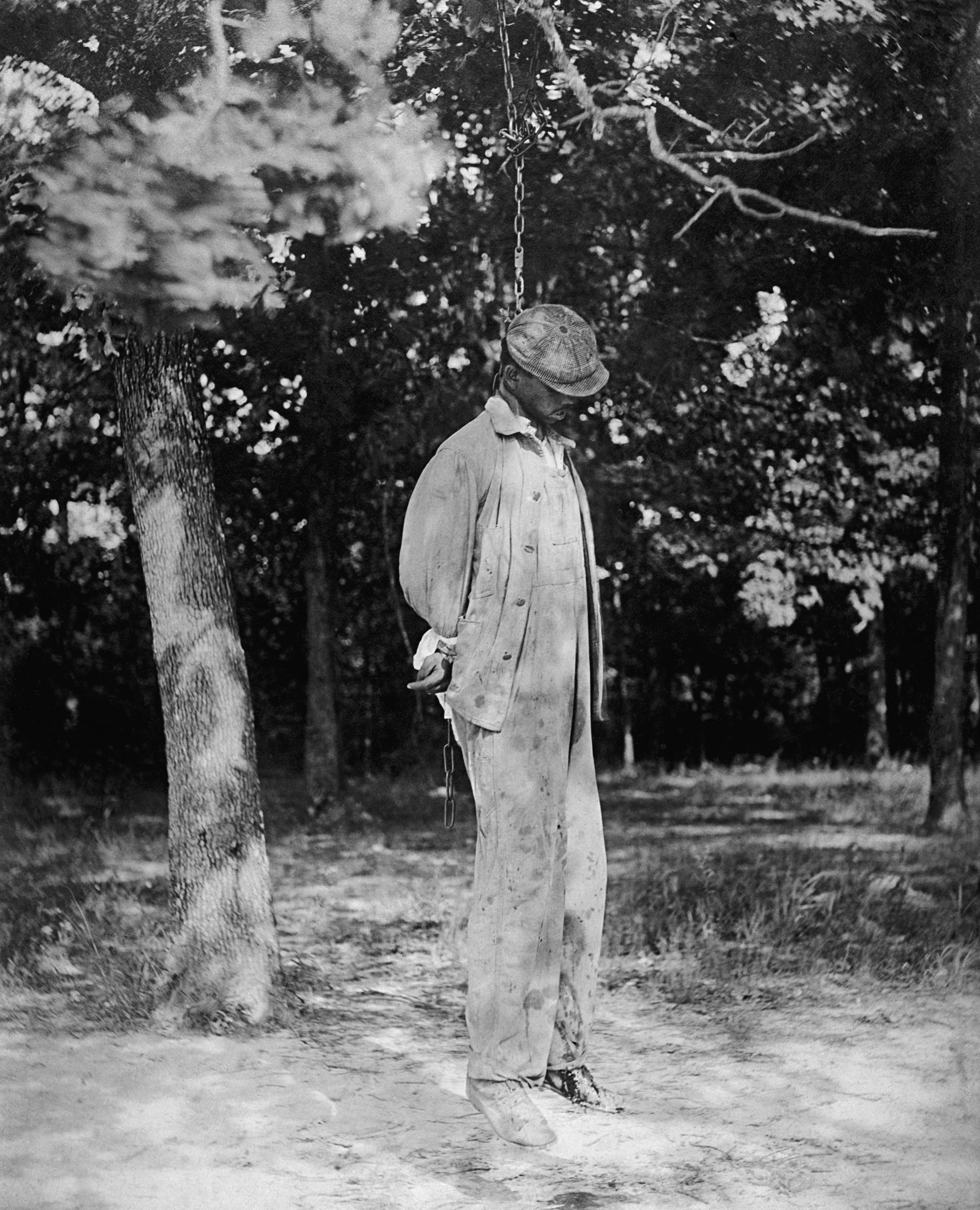|
Noose
A noose is a loop at the end of a rope in which the knot tightens under load and can be loosened without untying the knot. The knot can be used to secure a rope to a post, pole, or animal but only where the end is in a position that the loop can be passed over. Tying The knot is tied by forming a turn in the end of a rope, and then passing a bight in the standing part through. The noose knot is a slipped version of the overhand knot. Use in hanging The knot most closely associated with execution is the hangman's knot, which is also known as the "hangman's noose". Tying is similar to the original noose, but many turns are wrapped around the loop. The reason for this was to make the hanging more humane, as it would break the person's neck, killing the person instantly, rather than strangling them to death. A similar method is also commonly used for suicide. Search engines such as Google provide the phone number for a suicide helpline if a search for "how to tie a noose" ... [...More Info...] [...Related Items...] OR: [Wikipedia] [Google] [Baidu] |
Lynching In The United States
Lynching was the widespread occurrence of extrajudicial killings which began in the United States' Antebellum South, pre–Civil War South in the 1830s, slowed during the civil rights movement in the 1950s and 1960s, and continued until Lynching of Michael Donald, 1981. Although the victims of lynchings were members of various ethnicities, after roughly 4 million Slavery in the United States, enslaved African Americans were emancipated, they became the primary targets of white Southerners. Lynchings in the U.S. reached their height from the 1890s to the 1920s, and they primarily victimized Ethnic minority, ethnic minorities. Most of the lynchings occurred in the Southern United States, American South, as the majority of African Americans lived there, but Racism in the United States, racially motivated lynchings also occurred in the Midwestern United States, Midwest and Border states (American Civil War), border states. In 1891, the 1891 New Orleans lynchings, largest single ... [...More Info...] [...Related Items...] OR: [Wikipedia] [Google] [Baidu] |
Hanging
Hanging is killing a person by suspending them from the neck with a noose or ligature strangulation, ligature. Hanging has been a standard method of capital punishment since the Middle Ages, and has been the primary execution method in numerous countries and regions. The first known account of execution by hanging is in Homer's ''Odyssey''. Hanging is also a Suicide by hanging, method of suicide. Methods of judicial hanging There are numerous methods of hanging in execution that instigate death either by cervical fracture or by Strangling, strangulation. Short drop The short drop is a method of hanging in which the condemned prisoner stands on a raised support, such as a stool, ladder, cart, horse, or other vehicle, with the noose around the neck. The support is then moved away, leaving the person dangling from the rope. Suspended by the neck, the weight of the body tightens the noose around the neck, effecting strangulation and death. Loss of consciousness is typically rapid ... [...More Info...] [...Related Items...] OR: [Wikipedia] [Google] [Baidu] |
Overhand Knot
The overhand knot is one of the most fundamental knots, and it forms the basis of many others, including the simple noose, overhand loop, angler's loop, reef knot, fisherman's knot, half hitch, and water knot. The overhand knot is a stopper, especially when used alone, and hence it is very secure, to the point of jamming badly. It should be used if the knot is intended to be permanent. It is often used to prevent the end of a rope from unraveling. An overhand knot becomes a trefoil knot, a true knot in the mathematical sense, by joining the ends. It can also be adjusted, faired, or mis-tied as a half hitch. Tying There are a number of ways to tie the Overhand knot. * Thumb method – create a loop and push the working end through the loop with your thumb. * Overhand method – create a bight, by twisting the hand over at the wrist and sticking your hand in the hole, pinch the working end with your fingers and pull through the loop. Heraldry In heraldry, the overhan ... [...More Info...] [...Related Items...] OR: [Wikipedia] [Google] [Baidu] |
University Of Mississippi
The University of Mississippi (Epithet, byname Ole Miss) is a Public university, public research university in University, near Oxford, Mississippi, United States, with a University of Mississippi Medical Center, medical center in Jackson, Mississippi, Jackson. It is Mississippi's oldest public university and is the state's largest by enrollment. The Mississippi Legislature chartered the university on February 24, 1844, and in 1848 admitted its first 80 students. During the American Civil War, Civil War, the university operated as a Confederate States of America, Confederate hospital and narrowly avoided destruction by Ulysses S. Grant's forces. In 1962, during the civil rights movement, Ole Miss riot of 1962, a race riot occurred on campus when Racial segregation in the United States, segregationists tried to prevent the enrollment of African American student James Meredith. The university has since taken measures to improve its image. The university is closely associated with ... [...More Info...] [...Related Items...] OR: [Wikipedia] [Google] [Baidu] |
Capital Punishment
Capital punishment, also known as the death penalty and formerly called judicial homicide, is the state-sanctioned killing of a person as punishment for actual or supposed misconduct. The sentence (law), sentence ordering that an offender be punished in such a manner is called a death sentence, and the act of carrying out the sentence is an execution. A prisoner who has been sentenced to death and awaits execution is ''condemned'' and is commonly referred to as being "on death row". Etymologically, the term ''capital'' (, derived via the Latin ' from ', "head") refers to execution by Decapitation, beheading, but executions are carried out by List of methods of capital punishment, many methods, including hanging, Execution by shooting, shooting, lethal injection, stoning, Electric chair, electrocution, and Gas chamber, gassing. Crimes that are punishable by death are known as ''capital crimes'', ''capital offences'', or ''capital felonies'', and vary depending on the jurisdic ... [...More Info...] [...Related Items...] OR: [Wikipedia] [Google] [Baidu] |
Slip Knot
The slip knot is a stopper knot which is easily undone by pulling the tail ( working end). The slip knot is related to the running knot, which will release when the standing end is pulled. Both knots are identical and are composed of a slipped overhand knot, where a bight allows the knot to be released by pulling on an end; the working end for a slip knot, and the standing end for a running knot. The slip knot is used as a starting point for crochet and knitting. Standard creation The slip knot is formed by first creating a loop in the shape of a "p". Place a hand or hook through the loophole and grab a bight on the working end. Draw this bight through the first loop. Seat the knot and pull the bight until a small loop is created. See also * Knot * List of knots This list of knots includes many alternative names for common knots and lashings. Knot names have evolved over time, and there are many conflicting or confusing naming issues. The overhand knot, for example ... [...More Info...] [...Related Items...] OR: [Wikipedia] [Google] [Baidu] |
Double Overhand Noose
The double overhand noose is a very secure hitch knot. It might be used by cavers and canyoneers to bind a cow tail or a foot loop to a carabiner. Details File:Noeud double ganse-1.jpg, Make a bight (knot), bight File:Noeud double ganse-2.jpg, Turn around the standing end File:Noeud double ganse-3.jpg, the 2nd round riding turn, rides the 1st File:Noeud double ganse nouage.jpg, Tie inside the two rounds File:Noeud double ganse-4.jpg File:Noeud double ganse-5.jpg, Tighten A heavily tightened double overhand noose will jam. The bound object has to be removed before untying. As the double overhand knot, it neither slips nor turns around. However, a Triple fisherman's knot, third round turn might be useful with some highly lubricious spectra/nylon ropes. See also *List of hitch knots *List of knots Notes References {{Knots Hitch knots, Hitch knots ... [...More Info...] [...Related Items...] OR: [Wikipedia] [Google] [Baidu] |
Arbor Knot
The Arbor knot is a typical fishers' knot. Its primary use is to attach fishing line to the arbor of a fishing reel. It has also gained popularity (often under the name "Canadian Jam Knot" or nicknamed "bushcraft zip tie") as a general binding knot to tie down a roll of e.g. a sleeping bag, or to begin a lashing. Tying An arbor knot is tied by first passing the line around the reel arbor. The tag end is then tied in an overhand knot around the running line. Finally, an overhand knot is tied in the tag end. When tightened, the overhand knot in the tag end jams against the overhand knot tied around the running line. See also * List of knots References External links Arbor knot and other fishing knots* Fishing knots {{knot-stub ... [...More Info...] [...Related Items...] OR: [Wikipedia] [Google] [Baidu] |
Washington Post
''The Washington Post'', locally known as ''The'' ''Post'' and, informally, ''WaPo'' or ''WP'', is an American daily newspaper published in Washington, D.C., the national capital. It is the most widely circulated newspaper in the Washington metropolitan area and has a national audience. As of 2023, the ''Post'' had 130,000 print subscribers and 2.5 million digital subscribers, both of which were the List of newspapers in the United States, third-largest among U.S. newspapers after ''The New York Times'' and ''The Wall Street Journal''. The ''Post'' was founded in 1877. In its early years, it went through several owners and struggled both financially and editorially. In 1933, financier Eugene Meyer (financier), Eugene Meyer purchased it out of bankruptcy and revived its health and reputation; this work was continued by his successors Katharine Graham, Katharine and Phil Graham, Meyer's daughter and son-in-law, respectively, who bought out several rival publications. The ''Post ... [...More Info...] [...Related Items...] OR: [Wikipedia] [Google] [Baidu] |
James Meredith
James Howard Meredith (born June 25, 1933) is an American civil rights activist, writer, political adviser, and United States Air Force veteran who became, in 1962, the first African-American student admitted to the racially segregated University of Mississippi after the intervention of the federal government (an event that was a flashpoint in the civil rights movement). Inspired by President John F. Kennedy's inaugural address, Meredith decided to exercise his constitutional rights and apply to the University of Mississippi.Bryant 2006, p. 60. His goal was to put pressure on the Kennedy administration to enforce civil rights for African Americans. The admission of Meredith ignited the Ole Miss riot of 1962 where Meredith's life was threatened and 31,000 American servicemen were required to quell the violence – the largest ever invocation of the Insurrection Act of 1807. In 1966, Meredith planned a solo March Against Fear from Memphis, Tennessee, to Jackson, Mississippi; ... [...More Info...] [...Related Items...] OR: [Wikipedia] [Google] [Baidu] |
Lynching
Lynching is an extrajudicial killing by a group. It is most often used to characterize informal public executions by a mob in order to punish an alleged or convicted transgressor or to intimidate others. It can also be an extreme form of informal group social control, and it is often conducted with the display of a public spectacle (often in the form of a hanging) for maximum intimidation. Instances of lynchings and similar mob violence can be found in all societies. In the United States, where the word ''lynching'' likely originated, lynchings of African Americans became frequent in the South during the period after the Reconstruction era, especially during the nadir of American race relations. Etymology The origins of the word ''lynch'' are obscure, but it likely originated during the American Revolution. The verb comes from the phrase ''Lynch Law'', a term for a punishment without trial. Two Americans during this era are generally credited for coining the phrase: C ... [...More Info...] [...Related Items...] OR: [Wikipedia] [Google] [Baidu] |
Probation
Probation in criminal law is a period of supervision over an offence (law), offender, ordered by the court often in lieu of incarceration. In some jurisdictions, the term ''probation'' applies only to community sentences (alternatives to incarceration), such as suspended sentences. In others, probation also includes supervision of those conditionally released from prison on parole. An offender on probation is ordered to follow certain conditions set forth by the court, often under the supervision of a probation officer. During the period of probation, an offender faces the threat of being incarcerated if found breaking the rules set by the court or probation officer. Offenders are ordinarily required to maintain law-abiding behavior, and may be ordered to refrain from possession of firearms, remain employed, participate in an educational program, abide by a curfew, live at a directed place, obey the orders of the probation officer, or not leave the jurisdiction. The probationer ... [...More Info...] [...Related Items...] OR: [Wikipedia] [Google] [Baidu] |








